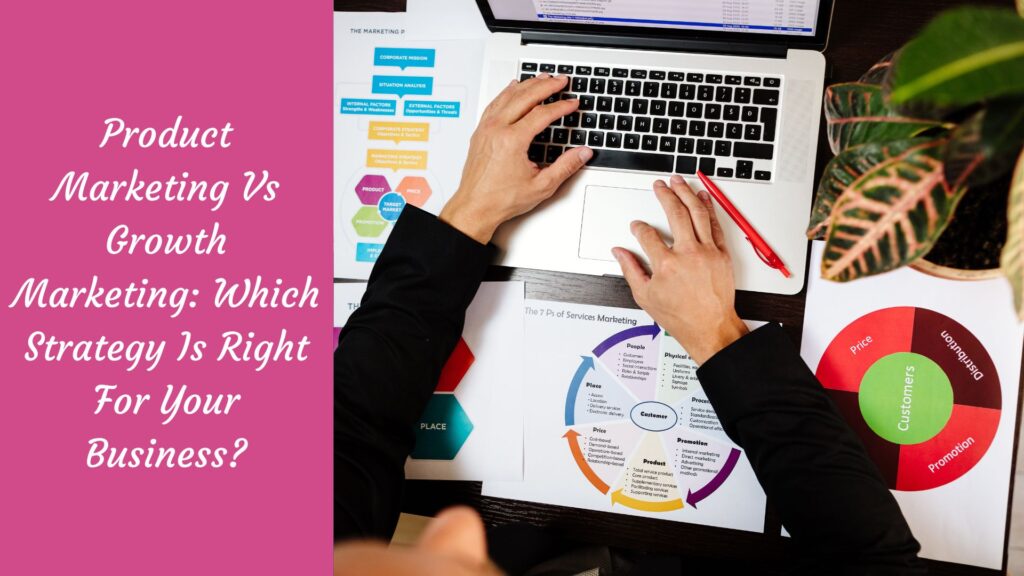Unlocking the secrets to skyrocketing growth and maximizing marketing impact – that’s what understanding the distinctions between Product Marketing and Growth Marketing is all about! 🚀
In this post, we’ll take you on an illuminating journey through the dynamic world of product marketing vs growth marketing. Discover the unique advantages each approach brings, and gain the essential knowledge to make informed decisions that will supercharge your business.
So, get ready to strap in and embark on this exhilarating adventure through the landscape of product marketing vs growth marketing! 💡
What is product marketing?

Product marketing lies at the intersection of marketing, sales, and product development, with a focus on communicating the product’s value to the market. It plays a vital role in bringing a product to market, driving demand and usage, and ultimately contributing to the product’s success.
Here are some key aspects of Product Marketing:
- Product Positioning: This involves defining where your product fits into the marketplace. For instance, is it a luxury item or a budget-friendly option? Is it aimed at teenagers or professionals? An example of successful product positioning is Tesla’s strategy of positioning their cars as both environmentally-friendly and a symbol of luxury.
- Go-to-Market Strategy: This refers to the plan you develop to deliver your product to the customers. It includes identifying the target audience, choosing the right marketing channels, and setting the pricing strategy. Apple’s iPhone releases are a great example of carefully crafted go-to-market strategies.
- Competitive Analysis: Understanding your competition allows you to differentiate your product and highlight its unique selling points. For example, Netflix constantly analyzes its competitors like Amazon Prime and Hulu to stay ahead in the streaming wars.
- Messaging: A critical aspect of product marketing is crafting the messaging that will resonate with your target audience and inspire them to take action. Nike’s “Just do it” campaign is a perfect example of powerful messaging that motivates consumers.
Product marketing isn’t a one-and-done task. It’s an ongoing process that requires regular adjustments based on market trends, customer feedback, and competitor activities.
What is growth marketing?

Growth marketing, often known as growth hacking, is a data-driven approach that aims at finding the most effective ways to grow a business. It comprises of the entire customer journey rather than focusing solely on acquisition.
The main goal is to attract more engaged customers. Here are some key aspects of Growth Marketing:
- A/B Testing: This involves testing different versions of your marketing campaigns to identify which one performs better. For example, Facebook often uses A/B testing to experiment with different features and designs to increase user engagement.
- Data Analysis: In growth marketing, data is your best friend. It helps to understand user behavior, identify patterns, and make data-informed decisions. E-commerce businesses like Amazon rely heavily on data analysis for personalized recommendations, thereby driving sales.
- User Acquisition: This refers to the strategies used to attract new users/customers to your business. Dropbox, for example, implemented a successful user acquisition strategy by offering additional free storage space to users who referred their friends.
- Retention: Growth Marketing doesn’t stop at acquiring new users. It aims to keep them engaged and turn them into loyal customers. Take for example Starbucks’ rewards program, which encourages repeat purchases by providing rewards, leading to customer retention.
- Optimization: Growth marketing involves continuous optimization of marketing strategies based on insights gained from performance metrics. Spotify, for instance, optimizes its music recommendation engine based on user listening habits to improve user experience and engagement.
Product marketing vs Growth marketing: 11 Key Differences Between
Here are the following product marketing vs growth marketing 11 differences:
Focus
Product marketing focuses on the product and its positioning in the market, aiming to drive demand and usage. On the other hand, growth marketing focuses on strategic, data-driven tactics to grow the user base and retain them.
Scope
Product marketing primarily deals with bringing a new product to market and driving its adoption, whereas growth marketing covers the entire customer journey, with a focus on acquisition, retention, and revenue generation.
Target Audience
Product marketing is typically outward-facing, focusing on potential customers and the broader market. In contrast, growth marketing is both outward and inward-facing, targeting potential customers but also focusing on existing customers to improve retention and increase revenue.
Methodology
Product marketing relies on traditional marketing methodologies and strategies, including product positioning, go-to-market strategy, competitive analysis, and messaging. Growth marketing, however, employs more experimental and innovative methods such as A/B testing, user acquisition tactics, and data-driven optimization strategies.
Metrics
Product marketing tracks metrics related to product adoption and usage, such as sales figures, market share, and customer feedback. Growth marketing, on the other hand, focuses on a broader set of key performance indicators (KPIs) including customer acquisition cost (CAC), lifetime value (LTV), churn rate, and engagement metrics.
Strategy Adjustment
While both types involve strategy adjustments, product marketing changes are generally more infrequent and tied to product development cycles. Growth marketing, however, requires continuous optimization based on real-time data analysis.
Timing
Product marketing comes into play before a product launches, creating the strategy for market introduction. Growth marketing is an ongoing process that starts after the product has been introduced to the market, aiming to scale the business.
Team Interaction
Product marketing often requires close collaboration with the product development and sales teams. Growth marketing typically involves cross-functional collaboration with teams such as product, sales, engineering, and even customer service.
Communication
Product marketing is all about storytelling – creating a compelling narrative about the product to drive sales. Growth marketing, on the other hand, is more about data-driven communication, using insights derived from user behavior and market trends to drive growth strategies.
Customer Understanding
Product marketing requires a deep understanding of the customer’s needs, pain points, and how the product can solve them. Growth marketing requires an understanding of the customer’s entire journey, their experiences, behaviors, and how these can be leveraged for growth.
Goal
The ultimate goal of product marketing is to increase product sales and improve market position. Meanwhile, the end goal of growth marketing is to acquire and retain customers, thereby driving sustainable business growth.

In the comparison of product marketing vs growth marketing neither strategy is better than the other – the right choice depends on your specific business needs, resources, and objectives. Often, a combination of both strategies can lead to the best outcomes.
Which Stretrategy to implement for Building a Successful Growth Marketing Framework for SaaS

A successful Growth Marketing Framework for a Software as a Service (SaaS) company requires a strategic blend of methodologies.
Here’s a structured approach that encapsulates both product marketing and growth marketing strategies:
- Understand Your Customer: Begin by developing a deep understanding of your customer’s pain points, needs, and journey. Use techniques such as customer interviews, surveys, and data analysis to create detailed customer personas and journey maps. This step is crucial for both product development and growth marketing strategies.
- Product Market Fit: Once you’ve gained a solid understanding of your customer, ensure your product delivers value and meets their needs. Conduct competitive analysis, market research, and continuously gather feedback to refine your product offering. This is essentially a Product Marketing strategy.
- Go-To-Market Strategy: Develop a go-to-market strategy to introduce your SaaS product to the market. This could involve a comprehensive launch plan, defining your unique selling proposition (USP), and creating a compelling story around your product. Again, this is a key aspect of Product Marketing.
- Acquisition Strategies: Implement robust user acquisition strategies to attract potential customers to your SaaS platform. This could involve Search Engine Optimization (SEO), pay-per-click (PPC) campaigns, content marketing, and social media advertising. This is where Growth Marketing begins to take shape.
- Activation and Onboarding: Once users sign up for your service, focus on their initial experience. Design an effective onboarding process that helps users understand and start using your product easily. A/B testing can be used to optimize this experience, a strategy often employed in Growth Marketing.
- Retention Strategies: Implement strategies to keep your users engaged and make them repeat customers. This could be through personalized email campaigns, offering valuable content, or developing a rewards program. Remember, retaining a customer is often more cost-effective than acquiring a new one.
- Optimization and Growth: Continuously analyze your user behavior data, marketing metrics, and feedback to optimize your strategies. This is a continuous process that involves A/B testing, experimenting with different strategies, and scaling what works best.

The key to a successful Growth Marketing Framework is an ongoing, iterative process of testing, learning, and optimizing. By blending the principles of both Product Marketing and Growth Marketing, you can create a holistic framework that drives sustainable growth for your SaaS business.
Conclusion
Product marketing and growth marketing are the dynamic duo that propels SaaS companies to success! 🚀
Product marketing crafts a compelling value proposition and positions the product for greatness. Meanwhile, growth marketing tirelessly optimizes strategies to acquire and retain customers. 💪
By combining these two approaches, companies can unlock the secret to sustainable business growth and conquer their goals. Understanding their power is key! 💡

